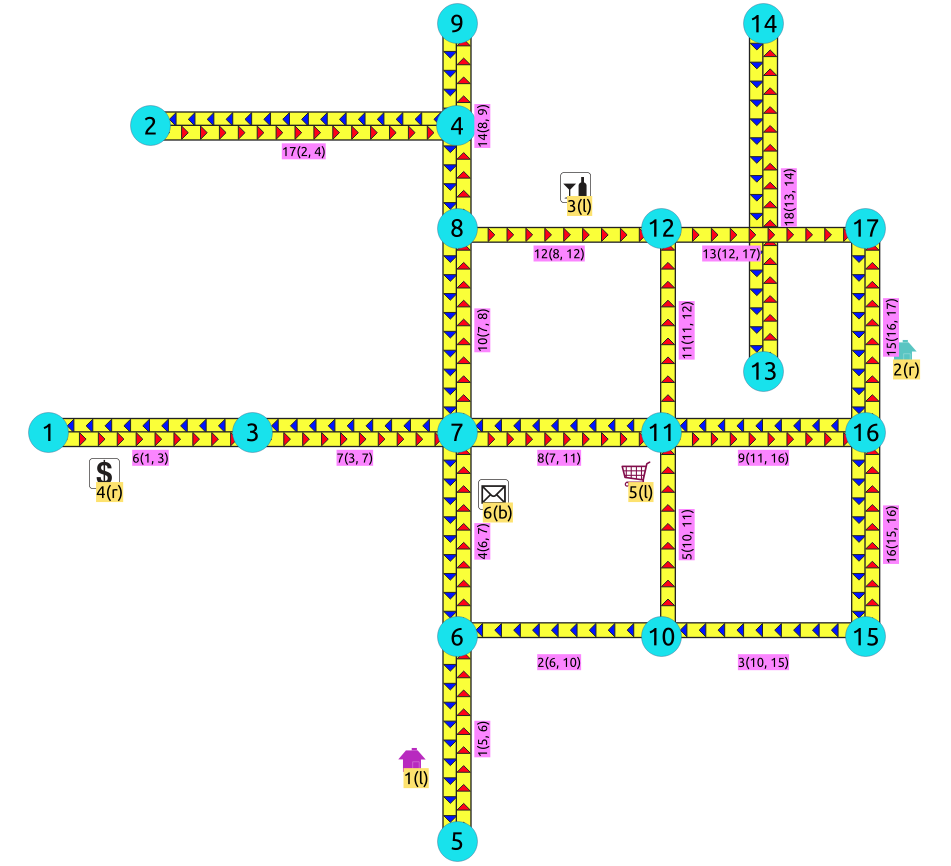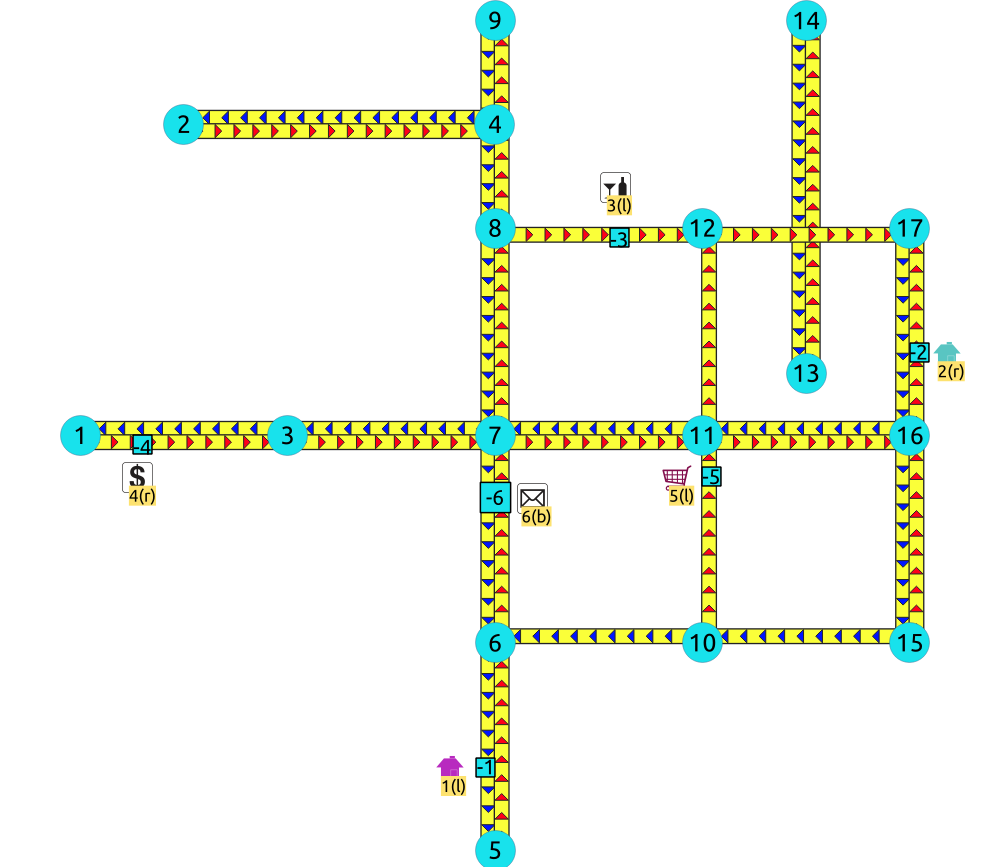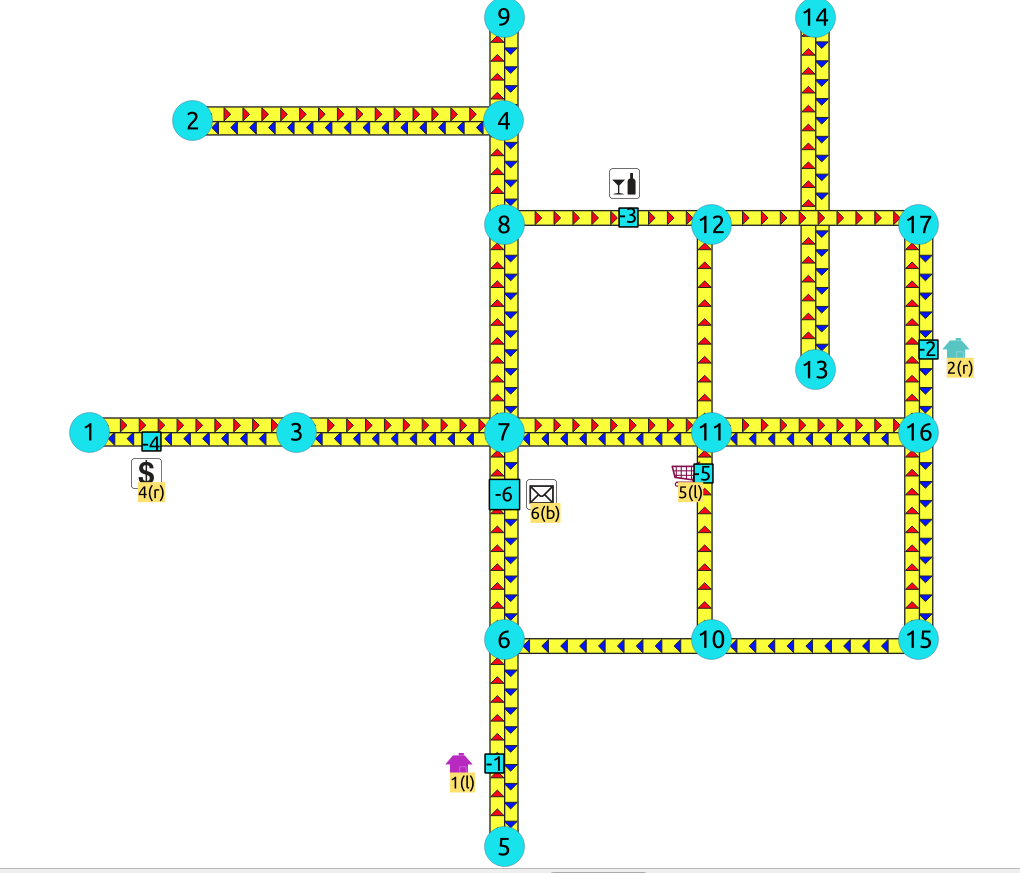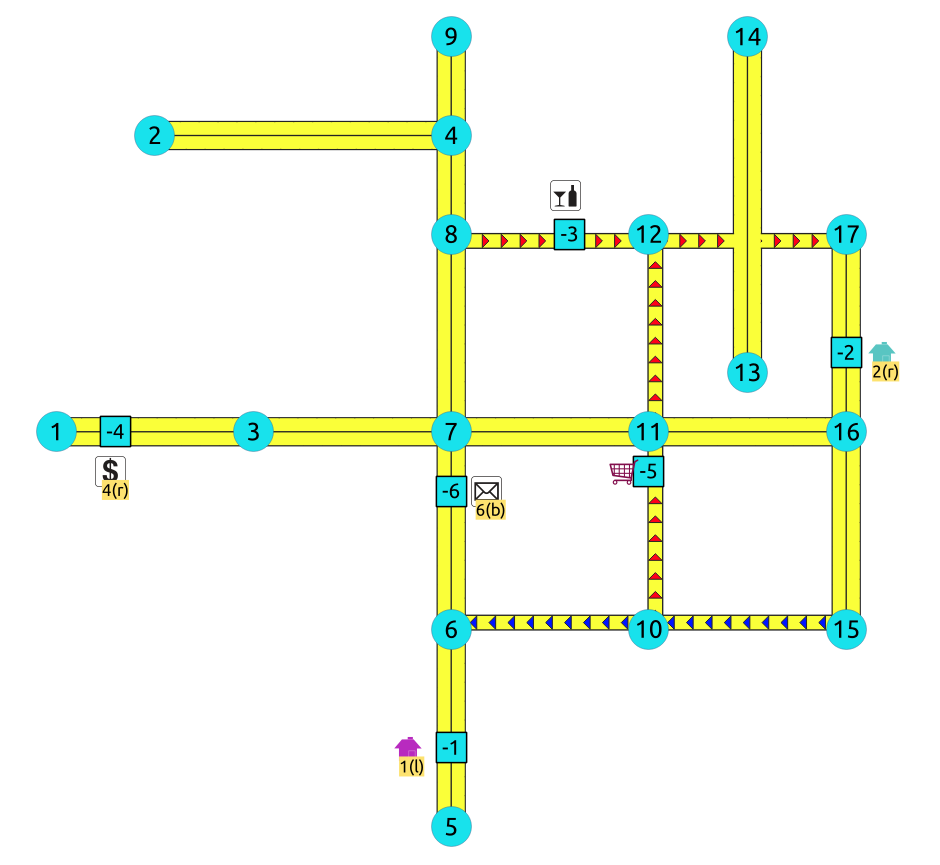Versiones no soportadas:2.6 2.5 2.4 2.3 2.2
withPoints - Familia de funciones¶
Cuando los puntos también se dan como entrada:
Advertencia
Funciones propuestas para la próxima versión mayor.
No están oficialmente en la versión actual.
Es probable que oficialmente formen parte del próximo lanzamiento:
Las funciones hacen uso de ENTEROS y FLOTANTES
Probablemente el nombre no cambie. (Pero todavía puede)
Es posible que la firma no cambie. (Pero todavía puede)
Probablemente la funcionalidad no cambie. (Pero todavía puede)
Se han hecho pruebas con pgTap. Pero tal vez se necesiten más.
Es posible que la documentación necesite un refinamiento.
pgr_withPoints - Ruta desde/hacia puntos en cualquier parte del grafo.
pgr_withPointsCost - Costos de las tutas más cortas.
pgr_withPointsCostMatrix - Costos de las rutas más cortas.
pgr_withPointsKSP - rutas más cortas K.
pgr_withPointsDD - Distancia de conducción.
pgr_withPointsVia - Ruteo vía ubicaciones
Introducción¶
This family of functions belongs to the withPoints- Categoría and the functions that compose them are based one way or another on dijkstra algorithm.
Depending on the name:
pgr_withPoints es pgr_dijkstra con puntos
pgr_withPointsCost es pgr_dijkstraCost con puntos
pgr_withPointsCostMatrix es pgr_dijkstraCostMatrix con puntos
pgr_withPointsKSP es pgr_ksp con puntos
pgr_withPointsDD es pgr_drivingDistance con puntos
pgr_withPoints es pgr_dijkstraVia con puntos
Parámetros¶
Columna |
Tipo |
Descripción |
|---|---|---|
|
SQL de aristas como se describe a continuación |
|
|
SQL de puntos como se describe abajo |
|
|
SQL de combinaciones como se describe a abajo |
|
salida |
|
Identificador del vértice inicial de la ruta. Valor negativo es para identificador de punto. |
salidas |
|
Arreglo de identificadores de vértices iniciales. Valores negativos son para identificadores de puntos. |
destino |
|
Identificador del vértice final de la ruta. Valor negativo es para identificador de punto. |
destinos |
|
Arreglo de identificadores de vértices finales. Valores negativos son para identificadores de puntos. |
Parámetros opcionales¶
Columna |
Tipo |
x Defecto |
Descripción |
|---|---|---|---|
|
|
|
|
Parámetros opcionales para Con puntos¶
Parámetro |
Tipo |
x Defecto |
Descripción |
|---|---|---|---|
|
|
|
Valor en [
|
|
|
|
|
Consultas Internas¶
SQL aristas¶
Columna |
Tipo |
x Defecto |
Descripción |
|---|---|---|---|
|
ENTEROS |
Identificador de la arista. |
|
|
ENTEROS |
Identificador del primer vértice de la arista. |
|
|
ENTEROS |
Identificador del segundo vértice de la arista. |
|
|
FLOTANTES |
Peso de la arista ( |
|
|
FLOTANTES |
-1 |
Peso de la arista (
|
Donde:
- ENTEROS:
SMALLINT,INTEGER,BIGINT- FLOTANTES:
SMALLINT,INTEGER,BIGINT,REAL,FLOAT
SQL de puntos¶
Parámetro |
Tipo |
x Defecto |
Descripción |
|---|---|---|---|
|
ENTEROS |
valor |
Identificador del punto.
|
|
ENTEROS |
Identificador de la arista «más cercana» al punto. |
|
|
FLOTANTES |
El valor en <0,1> que indica la posición relativa desde el primer punto de la arista. |
|
|
|
|
Valor en [
|
Donde:
- ENTEROS:
SMALLINT,INTEGER,BIGINT- FLOTANTES:
SMALLINT,INTEGER,BIGINT,REAL,FLOAT
SQL Combinaciones¶
Parámetro |
Tipo |
Descripción |
|---|---|---|
|
ENTEROS |
Identificador del vértice de partida. |
|
ENTEROS |
Identificador del vértice de llegada. |
Donde:
- ENTEROS:
SMALLINT,INTEGER,BIGINT
Documentación Avanzada¶
Sobre los puntos¶
For this section the following city (see Datos Muestra) some interesting points such as restaurant, supermarket, post office, etc. will be used as example.

El grafo es dirigido
Las flechas rojas muestran``(source, target)`` de la arista en al tabla de aristas
La flechas azules muestran
(target, source)la arista en la tabla de aristasCada ubicación de los puntos muestra su ubicación en relación con la arista
(source, target)A la derecha para los puntos 2 y 4.
A la izquierda para los puntos 1, 3 y**5**.
En ambos lados para el punto 6.
La representación de la base de datos sigue la descripción SQL de puntos , y para este ejemplo:
SELECT pid, edge_id, fraction, side FROM pointsOfInterest;
pid | edge_id | fraction | side
-----+---------+----------+------
1 | 1 | 0.4 | l
4 | 6 | 0.3 | r
3 | 12 | 0.6 | l
2 | 15 | 0.4 | r
5 | 5 | 0.8 | l
6 | 4 | 0.7 | b
(6 rows)
Lado de manejo¶
In the following images:
Los vértices cuadrados son vértices temporales,
Los vértices temporales se agregan según el lado de conducción,
visualmente mostrando las diferencias dependiendo de como se interpreta la información de lado de conducción.
Lado de manejo derecho¶

Punto**1** ubicado en la arista
(6, 5)Punto 2 ubicado en la arista``(16, 17)``
Punto 3 ubicado en la arista``(8, 12)``
Punto 4 ubicado en la arista``(1, 3)``
Punto 5 ubicado en la arista``(10, 11)``
Punto 6 ubicado en las aristas
(6, 7)y(7, 6)
Lado de manejo izquierdo¶

Punto**1** ubicado en la arista
(5, 6)Punto 2 ubicado en la arista``(17, 16)``
Punto 3 ubicado en la arista``(8, 12)``
Punto 4 ubicado en la arista``(3, 1)``
Punto 5 ubicado en la arista``(10, 11)``
Punto 6 ubicado en las aristas
(6, 7)y(7, 6)
Lado de manejo no importa¶
Como si se tuvieran todos los puntos en ambos lados considerados como
bPreferred usage on undirected graphs
En TRSP - Familia de funciones esta opción no es válida

Punto**1** ubicado en la arista``(5, 6)`` y
(6, 5)Punto 2 ubicado en la arista``(17, 16)`` y
(16, 17)Punto 3 ubicado en la arista``(8, 12)``
Point 4 located on edge
(3, 1)and(1, 3)Punto 5 ubicado en la arista``(10, 11)``
Punto 6 ubicado en las aristas
(6, 7)y(7, 6)
Creación de vértices temporales¶
This section will demonstrate how a temporary vertex is created internally on the graph.
Problem
For edge:
SELECT id, source, target, cost, reverse_cost
FROM edges WHERE id = 15;
id | source | target | cost | reverse_cost
----+--------+--------+------+--------------
15 | 16 | 17 | 1 | 1
(1 row)
insert point:
SELECT pid, edge_id, fraction, side
FROM pointsOfInterest WHERE pid = 2;
pid | edge_id | fraction | side
-----+---------+----------+------
2 | 15 | 0.4 | r
(1 row)
En una red de conducción del lado derecho¶
Lado de manejo derecho

Arrival to point
-2can be achieved only via vertex 16.Does not affects edge
(17, 16), therefore the edge is kept.Sólo afecta a la arista
(16, 17), por lo que la arista se elimina.Crear dos aristas nuevas:
Edge
(16, -2)with cost0.4(original cost * fraction ==Edge
(-2, 17)with cost0.6(the remaining cost)
The total cost of the additional edges is equal to the original cost.
If more points are on the same edge, the process is repeated recursevly.
En una red de conducción del lado izquierdo¶
Lado de manejo izquierdo

Arrival to point
-2can be achieved only via vertex 17.Does not affects edge
(16, 17), therefore the edge is kept.Sólo afecta a la arista
(17, 16), por lo que la arista se elimina.Crear dos aristas nuevas:
Work with the original edge
(16, 17)as the fraction is a fraction of the original:Edge
(16, -2)with cost0.4(original cost * fraction ==Edge
(-2, 17)with cost0.6(the remaining cost)If more points are on the same edge, the process is repeated recursevly.
Flip the Edges and add them to the graph:
Edge
(17, -2)becomes(-2, 16)with cost0.4and is added to the graph.Edge
(-2, 16)becomes(17, -2)with cost0.6and is added to the graph.
The total cost of the additional edges is equal to the original cost.
Cuando el lado de conducción no importa¶

Arrival to point
-2can be achieved via vertices 16 or 17.Afecta las aristas
(16, 17)y(17, 16)por lo que esas aristas se eliminan.Crear cuatro nuevas aristas:
Work with the original edge
(16, 17)as the fraction is a fraction of the original:Edge
(16, -2)with cost0.4(original cost * fraction ==Edge
(-2, 17)with cost0.6(the remaining cost)If more points are on the same edge, the process is repeated recursevly.
Flip the Edges and add all the edges to the graph:
Edge
(16, -2)is added to the graph.Edge
(-2, 17)is added to the graph.Edge
(16, -2)becomes(-2, 16)with cost0.4and is added to the graph.Edge
(-2, 17)becomes(17, -2)with cost0.6and is added to the graph.
Ver también¶
Índices y tablas